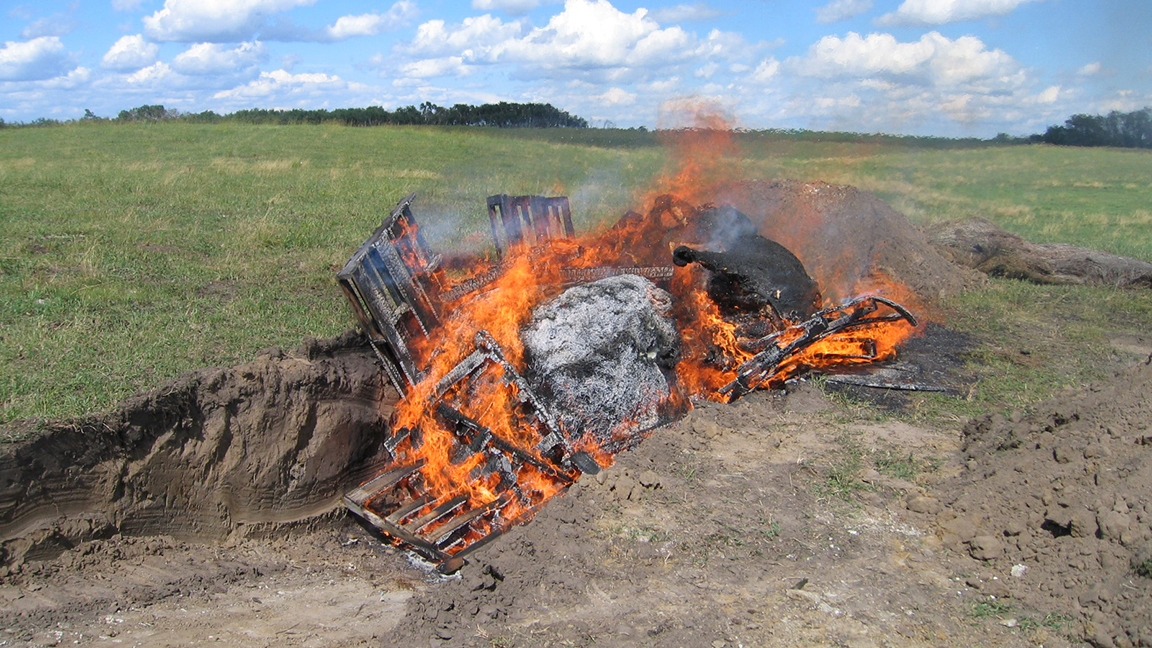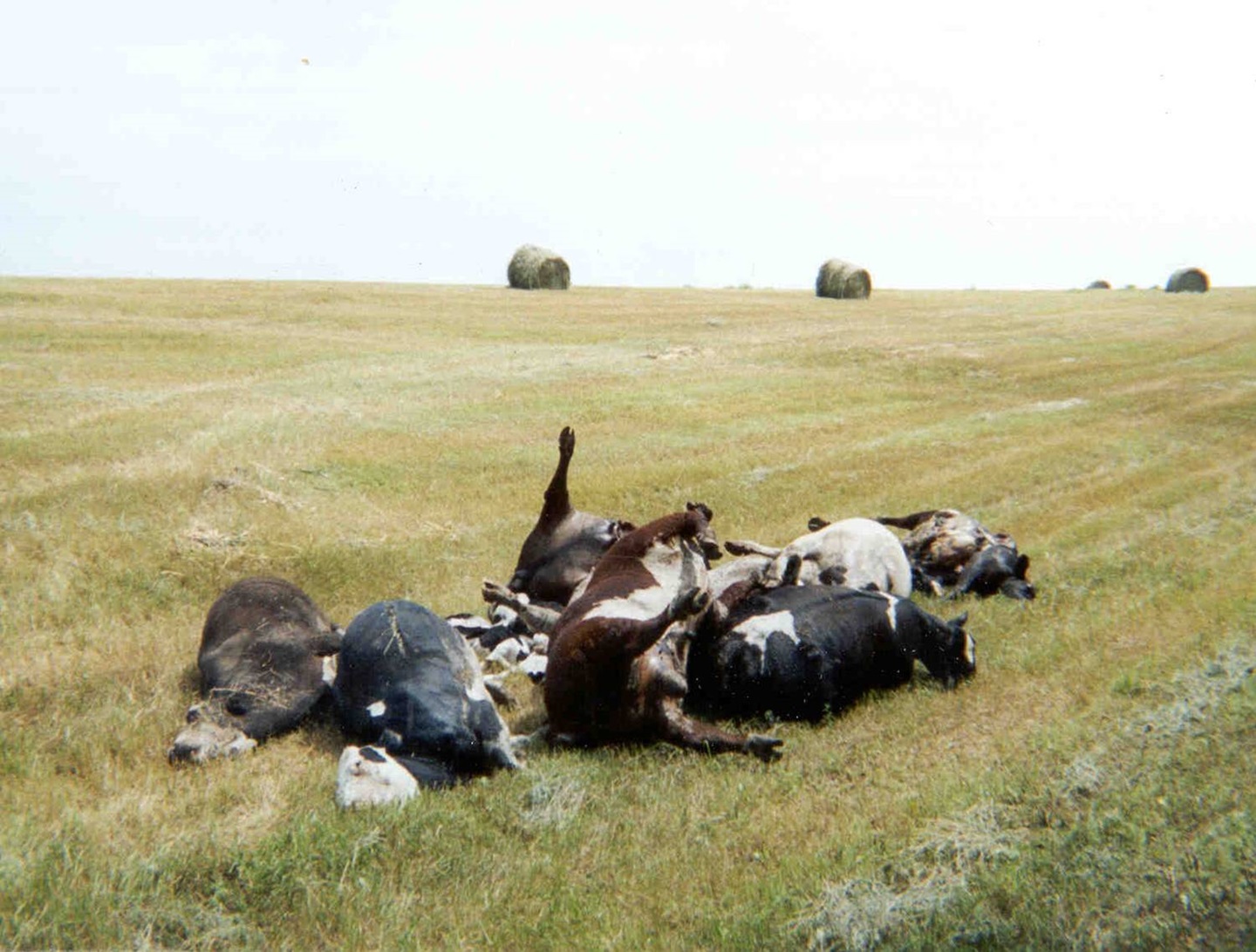Anthrax: Sporadic, but Deadly
The bacterium-driven illness has been confirmed in Wyoming beef cattle herds.
October 22, 2024

[Photo by Martin Hugh-Jones.]
Anthrax is one of the oldest killers of humans and livestock mentioned in some of the earliest recorded history. It is caused by a bacterium, Bacillus anthracis, and occurs sporadically in the United States and Canada, as well as other countries around the world. It is mainly associated with sudden death of cattle and sheep, but it can infect all warm-blooded animals.
Wyoming experienced an outbreak this fall — in beef herds for the first time since the 1970s, and in a moose for the first time since 1956. The Wyoming State Veterinary Laboratory confirmed the disease in several cattle herds in Carbon County on Aug. 31. More than 50 cattle died. Last year in North Dakota at least 25 cases were confirmed.
This acutely infectious and deadly disease is generally not spread from live animal to live animal. Rather, it is transmitted via spores found in carcasses of animals that died of the disease. Most commonly it is found in soil that contains spores as the carcass breaks down or scavengers consume the carcass. Birds can pick up carcass pieces and fly away, enlarging the area of spread.
Once the animal dies, the carcass is opened and bacteria are exposed to the air, the bacteria form spores. The spores are resistant to heat, cold, freezing, chemical disinfectants and drying, and they can survive in contaminated soil a long time.

According to the Merck Veterinary Manual, acute cases of anthrax are denoted by an abrupt onset of fever (which may reach 107° F) and a period of excitement followed by “lethargy, stupor, respiratory or cardiac distress, staggering, seizures and death.”
Once the animal dies, the carcass is opened and bacteria are exposed to the air, the bacteria form spores. The spores are resistant to heat, cold, freezing, chemical disinfectants and drying, and they can survive in contaminated soil a long time. The carcass may be long gone — torn apart by predators and scattered, or decomposed and disappeared years ago — but the spores are still viable in the surrounding soil.
2006 experience
Veterinarian Tasha Epp, Western College of Veterinary Medicine (Saskatchewan), was involved in a study of anthrax during an outbreak in western Canada in 2006.
“My area of expertise is epidemiology, so I was looking at what happened and where it happened, and factors associated with that outbreak,” she explains.
“Areas with heavy rainfall and flooding in the spring and then dry conditions later in the summer were more likely to have cases,” Epp says. “When flooded areas dried out in hot weather, we started seeing anthrax. This is typical.”
Changes in soil moisture or recent soil disturbance (such as excavation) can expose spores to the soil surface.
“Moisture draws spores from the ground, and then when flooded areas dry out, the cows go back to those areas where there is grass and ingest spores that end up on grass,” she explains. “That combination of wet, then hot and dry, tends to make a bad year for anthrax.”
In the 2006 outbreak, 800 animals were confirmed with anthrax in Saskatchewan alone. It was the largest number of cases ever recorded.
Most occurrences happen in areas that have experienced anthrax in the past; however, not all animals are diagnosed or found before the body begins to break down and release the spores.
“So, we don’t have complete records of every place that has experienced anthrax events,” Epp says. “Since these bacteria can stay in the soil for decades and remain viable, predicting which animals are at risk is difficult. Many of the farms affected in 2006 were required to use vaccination, but livestock vaccinations have probably not been kept up since that time.”
While anthrax seems to appear in cattle most frequently, bison were also hit hard in 2006.
“We hadn’t seen it much in farmed bison in the past, perhaps because bison farming wasn’t so large in earlier years,” Epp says. “Now that we have more bison farms, we see more anthrax cases in bison. In 2006 on bison farms we saw more deaths than we would have seen with cattle.”
Since very few ranchers are now using the vaccine, livestock populations could have lost prior exposure immunity and may be at risk to anthrax during drought conditions.
This disease probably affected bison in North America long before there were any cattle here.
“A researcher who is now in Florida has looked at potential distribution of anthrax spores in Mexico, the U.S. and Canada. He mapped it out, and a lot of it seems to follow old cattle trails and bison migration routes — where animals died in years past,” she explains. Basically, any warm-blooded animal that grazes can become exposed.
“The majority of anthrax cases are not found in time to treat; the animal is usually dead because it’s such a fast onset of disease,” Epp says. “There have only been a few that people tried to treat.” Penicillin is effective, but it has to be given in very early stages.
“There is an effective vaccine, but because we don’t see cases very often, most ranchers don’t vaccinate. If there was a way to predict where and when anthrax would occur, perhaps more people would do it.”
Editor’s note: Heather Smith Thomas is a freelance writer and cattlewoman from Salmon, Idaho. [Photos by Martin Hugh-Jones.]
Angus Beef Bulletin EXTRA, Vol. 16, No. 10-B
Topics: Health , Industry News , News
Publication: Angus Beef Bulletin


